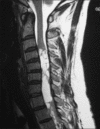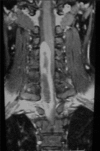Spinal coning after lumbar puncture in a patient with undiagnosed giant cervical neurofibroma
- PMID: 24101840
- PMCID: PMC3788304
- DOI: 10.4103/0972-2327.116935
Spinal coning after lumbar puncture in a patient with undiagnosed giant cervical neurofibroma
Abstract
Lumbar puncture in the presence of an intracranial tumor with raised intracranial pressure is known to have catastrophic consequences due to herniation of intracranial contents through the tentorial hiatus or foramen magnum. There are relatively few case reports about the same sequence of events when lumbar puncture is performed below the level of a complete spinal block. The mechanism of such deterioration is also subject to conjecture as the spinal cord (unlike the uncus or cerebellar tonsils) is tethered by the dentate ligament and roots on either side, and is hence less mobile. We present one such case of spinal coning and review the available literature.
Keywords: Cervical neurofibroma; lumbar puncture; spinal coning.
Conflict of interest statement
Figures




References
-
- Hollis PH, Malis LI, Zapulla PA. Neurological deterioration after lumbar puncture below complete spinal subarachnoid block. J Neurosurg. 1986;64:253–6. - PubMed
-
- Mutoh S, Aikou I, Ueda S. Spinal coning after lumbar puncture in prostate cancer with asymptomatic vertebral metastases: A case report. J Urol. 1991;145:834–5. - PubMed
-
- Morgan RJ, Steller PH. Acute paraplegia following intrathecal phenol block in the presence of occult epidural malignancy. Anaesthesia. 1994;49:142–4. - PubMed
-
- Appelgren L, Nordborg C, Sjoberg M, Karlsson PA, Nitescu P, Curelaru I. Spinal epidural metastasis: Implications for spinal analgesia to treat “refractory” cancer pain. J Pain Symptom Manage. 1997;13:25–42. - PubMed
Publication types
LinkOut - more resources
Full Text Sources
Other Literature Sources

